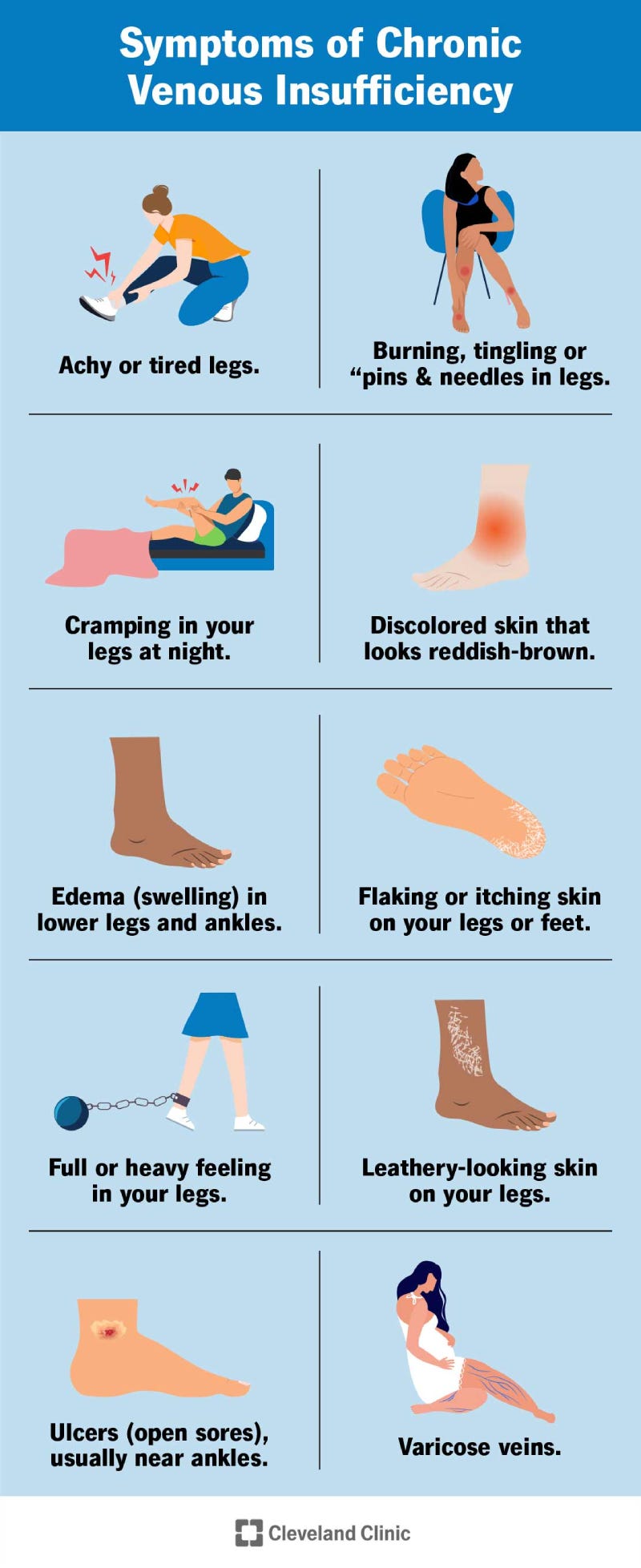President medical exam for swelling in legs, hand bruising…
Rare acknowledgement of health concerns…
CVI causes damage to the valves, and the result is leg swelling and blood pools in the legs. One can get swelling or ulcers. The reality is the blood in lower limbs have a harder time in getting back to the heart. Impacts 1 in 20 adults (older folk). Because the blood pools in lower legs, the pressure increases there, and the smallest of blood vessels (capillaries) bust. Skin may become red-brown in that area. POTUS Trump is likely impacted this way, and it is way common among many of us as we age.
‘CVI usually isn’t life-threatening and doesn’t result in amputation. But it’s a progressive disease that can cause discomfort, pain and reduced quality of life. Treatment can help manage your symptoms and give you a better quality of life.’
I am sharing this as a PSA given seems POTUS Trump has this, and it is not unusual.
‘These burst capillaries can cause:
-
Tissue inflammation in that area.
-
Tissue damage.
-
Venous stasis ulcers. These are open sores on your skin’s surface.
Venous stasis ulcers don’t heal easily, and they can become infected. The infection could spread to nearby tissue. This condition is known as cellulitis, which is dangerous if not treated right away.’ Chronic Venous Insufficiency: Causes, Symptoms and Treatment
‘President Trump underwent medical testing for “mild swelling” in his legs and bruising on his hand, which revealed a vein condition that is common in people over the age of 70, the White House said Thursday.
White House press secretary Karoline Leavitt shared a note from Trump’s physician during a press briefing that detailed the exam. Trump underwent ultrasounds and a “comprehensive exam” that included a diagnostic vascular study.’
The exam found Trump, 79, has chronic venous insufficiency. The condition happens when an individual’s leg veins struggle to pump blood back to the heart, causing blood to pool, according to the Cleveland Clinic.’
Symptoms and Causes

What are the signs and symptoms of chronic venous insufficiency?
Chronic venous insufficiency signs and symptoms include:
-
Achy or tired legs.
-
Burning, tingling or “pins and needles” sensation in your legs.
-
Cramping in your legs at night.
-
Discolored skin that looks reddish-brown.
-
Edema (swelling) in your lower legs and ankles, especially after standing a while or at the end of the day.
-
Flaking or itching skin on your legs or feet.
-
Full or heavy feeling in your legs.
-
Leathery-looking skin on your legs.
-
Ulcers (open sores), usually near your ankles. If they’re very painful, they may be infected.
-
Varicose veins.
Severe edema in your lower leg can cause scar tissue to develop. This scar tissue traps fluid in your tissues. Your calf may feel large and hard to the touch. When this happens, your skin is more vulnerable to persistent ulcers.
You may not have all of these issues at once. Instead, you may only have one or two. Your signs and symptoms depend on how far your condition has progressed.
What are the stages of chronic venous insufficiency?
The stages of venous disorders range from 0 to 6. “Venous disorders” is a general category for many possible issues with your veins, including CVI. The stages are based on clinical signs, which are things your provider can see or feel when they examine your legs.
Venous disorder stages include:
-
Stage 0: No signs that can be seen or felt. You may feel symptoms like achy or tired legs.
-
Stage 1: Visible blood vessels, including spider veins.
-
Stage 2: Varicose veins at least 3 millimeters wide.
-
Stage 3: Edema (swelling) but no skin changes.
-
Stage 4: Changes to your skin’s color and/or texture.
-
Stage 5: Healed ulcer.
-
Stage 6: Acute (active) ulcer.
You’ll be diagnosed with chronic venous insufficiency if you’re at stage 3 or above. In other words, having varicose veins doesn’t mean you have CVI. But varicose veins are a sign of blood flow problems that could get worse over time. So, it’s important to tell your provider about any new varicose veins you notice.
What causes chronic venous insufficiency?
Chronic venous insufficiency happens when the valves in your leg veins don’t work properly. Your leg veins contain valves that help your blood flow in the correct direction (toward your heart). If a valve becomes damaged, it can’t close properly. Gravity takes over, and blood struggles to flow upward toward your heart. It instead flows backward, a situation known as venous reflux.
Causes of valve malfunction may be congenital, primary or secondary.
-
Congenital causes are malformations in your leg veins that you’re born with. For example, some people are born without valves in their leg veins.
-
Primary causes are any changes to your leg veins that prevent them from working as they should. For example, your vein may get too wide, preventing its valve from closing all the way.
-
Secondary causes are other medical issues that damage your leg veins. Deep vein thrombosis (DVT) is usually the culprit. The thrombus (blood clot) leaves behind scar tissue that damages your valve.
What is the most common cause of chronic venous insufficiency?
Deep vein thrombosis (DVT) is the most common cause of chronic venous insufficiency. The blood clot damages the valve in your leg vein. People with a history of DVT face a higher risk of developing CVI.
Diagnosis and Tests
How is chronic venous insufficiency diagnosed?
Chronic venous insufficiency is diagnosed through a physical exam and ultrasound imaging. During the physical exam, your provider will:
-
Carefully examine your legs. Your provider will look for clinical signs of CVI, like ulcers or changes in skin color.
-
Perform a vascular ultrasound. This painless test uses sound waves to create an image of your veins. It shows which parts of your veins are damaged.
Your provider will also rule out other medical conditions that could be causing your symptoms. This may involve other tests like an MRI.
Many people with CVI also have peripheral artery disease (PAD). So, your provider may ask questions or run tests to check you for PAD. If you have both CVI and PAD, your provider will advise you on treatment methods and precautions you need to take with compression therapy.
Management and Treatment
What are the treatments for chronic venous insufficiency?
Treatment for chronic venous sufficiency involves lifestyle changes and compression therapy. If these measures aren’t enough, your provider may recommend a procedure or surgery. The best treatment for you depends on how far your condition has progressed and other medical conditions you have. Your provider will tailor treatment to your individual needs.
The goals of treatment are to:
-
Help your blood flow better in your veins.
-
Help ulcers heal and limit their chances of coming back.
-
Improve your skin’s appearance.
-
Reduce pain and swelling.
Lifestyle changes
Usually, providers recommend lifestyle changes as the first method of treatment for CVI. These include:
-
Leg elevation: Lifting your legs above the level of your heart can help reduce pressure in your leg veins. Your provider may suggest you do this for 30 minutes or longer at least three times per day.
-
Exercise: Walking and other forms of exercise can help blood flow better in your leg veins. Each time you take a step, your calf muscle squeezes and helps your veins pump blood back up to your heart. This “calf muscle pump” is known as your “second heart.” It helps blood in your legs defy gravity, and it’s vital for your circulation. So, making your calf muscles stronger can help improve your blood flow. Your provider may also recommend foot and ankle flexing exercises.
-
Weight management: Extra weight can put pressure on your veins and damage the valves. Ask your provider what a healthy weight is for you. Work with your provider to come up with a healthy and manageable plan for achieving that weight.
Compression therapy
Providers commonly recommend compression therapy for treating CVI. Compression therapy helps ease swelling and discomfort in your legs.
There are many types of compression bandages and stockings. Some offer more compression than others. Very tight stockings require a prescription.
Some stockings are “graduated,” meaning they’re tighter down by your ankles and less tight further up your leg. It’s essential that you follow your provider’s guidance on the type of compression you need and when to use it.
Many people with CVI struggle to wear compression stockings over the long term. But compression therapy is very important to help your veins work better and ease your symptoms. If you struggle with compression therapy, talk with your provider. You may need a different type of stocking. Or, your provider may offer advice to make the treatment plan more doable for you.
If stockings don’t help, your provider may suggest intermittent pneumatic compression (IPC). IPC devices are inflatable sleeves you wear on your legs that help blood flow through your veins.
People who have peripheral artery disease (PAD) need to be careful with compression therapy. Your provider may caution you not to use it at all depending on the extent of your PAD. Closely follow your provider’s instructions.
Medications
Medications used to treat CVI include:
-
Antibiotics to clear skin infections or ulcers caused by CVI. These medications don’t treat the underlying disease.
-
Anticoagulants, or “blood thinners,” to treat blood clots and prevent future blood clots from forming.
-
Medicated wrap known as an Unna boot. This wrap combines multilayer compression with a zinc oxide gel-based wound cover that forms a semi-rigid bandage.
Chronic Venous Insufficiency: Causes, Symptoms and Treatment
Outlook / Prognosis
What can I expect if I have chronic venous insufficiency?
CVI usually isn’t life-threatening and doesn’t result in amputation. But it’s a progressive disease that can cause discomfort, pain and reduced quality of life. Treatment can help manage your symptoms and give you a better quality of life.
Venous ulcers are difficult to treat, and they may return even after treatment. It’s important to keep all your medical appointments and closely follow your provider’s guidance.’
Click this link for the original source of this article.
Author: Dr. Paul Alexander
This content is courtesy of, and owned and copyrighted by, https://palexander.substack.com and its author. This content is made available by use of the public RSS feed offered by the host site and is used for educational purposes only. If you are the author or represent the host site and would like this content removed now and in the future, please contact USSANews.com using the email address in the Contact page found in the website menu.











